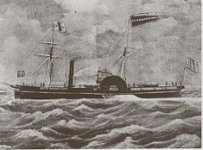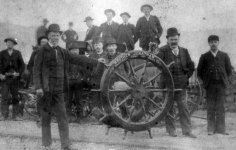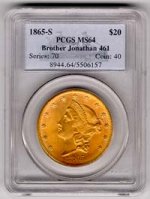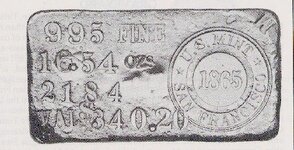pegleglooker
Bronze Member
- Jun 9, 2006
- 1,857
- 238
- Detector(s) used
- ace 250
- Primary Interest:
- All Treasure Hunting
The story of the Brother Jonathan

On her last voyage, on a Friday, the ship ran into a heavy gale within hours after leaving San Francisco harbor and steaming north. Most of the passengers onboard the Brother Jonathan became seasick and were confined to their rooms by the continuing storm of “frightful winds and stormy seas”. Early Sunday morning, the steamer anchored in Crescent City harbor on the first leg of its trip to Portland and Victoria, B.C. After leaving the safety of the bay that Sunday afternoon, the ship ran headfirst into more stormy conditions. The seas were so bad near the California-Oregon border that the captain ordered the ship turned around for the safety of Crescent City.[3] Forty-five minutes later on that return and close to port, the ship struck the rock, tearing a large hole in its hull. Within five minutes, the captain realized the ship was going to sink and ordered the passengers and crew to abandon ship. Despite having enough lifeboats to hold all of the people on board, only three were able to be deployed. Acts of courage and desperation, fear and self-sacrifce, were numerous.[4] The rough waves capsized the first one that was lowered and smashed the second against the vessel's sides. Only a single surfboat, holding eleven crew members, five women and three children managed to escape the wreck and make it safely to Crescent City.

Among the victims were Brigadier General George Wright, the Union Commander of the Department of the Pacific; Dr. Anson G. Henry, Surveyor General of the Washington Territory, who was also Abraham Lincoln’s physician and closest friend; James Nisbet, a well-known publisher, who wrote a love note and his will while awaiting his death; and Roseanna Keenan, a colorful San Francisco madam, who was traveling with seven “soiled doves”. As a result of this tragedy, new laws were written to increase passenger-ship safety, including the ability of lifeboats to be released from a sinking ship.[5]
Divers and ships began searching for the sunken treasure two weeks after the July 30, 1865, disaster. Crates of gold coins had been loaded on the vessel, including the annual treaty payments in gold for Indian tribes, Wells Fargo shipments consigned for Portland and Vancouver (B.C.), and gold carried onboard by the passengers. A large ship’s safe safeguarded valuable jewelry, more gold coins, and gold bars. The gold alone was valued at $50 million dollars in today’s dollars. [6] Despite the attempts of numerous salvors, for over 125 years, the ship’s treasure of gold and artifacts remained one of the Pacific’s great secrets.
Modern recovery efforts
Despite the fact that the Brother Jonathan sank so tantalizingly close to shore, the ferocious storms, rocky passageways, strong underwater currents, and darkness at the depths held the secret of her location. Although the ship sunk eight miles from Crescent City, technology needed to improve and explorers had to change their assumptions. On the last day of its 1993 expedition, Deep Sea Research (DSR) changed its theory. The men decided that the ship had actually floated underneath the ocean's surface to finally hit bottom two miles from where it first smashed into the reef. Led by Donald Knight and under risky conditions, a mini-sub on October 1, 1993, discovered the ship there at the last-minute. The team over time began to bring artifacts back from a depth of 275 feet.
No human remains were ever found. However, in 1996 a mini-sub scooted past a suspicious “glint” on the bottom. On August 30, 1996, divers found the first gold coins and on that expedition recovered 875 1860s gold coins in near-mint condition.

Over time, the salvors recovered 1207 extraordinarily valuable gold coins, primarily $20 Double Eagles, in addition to numerous artifacts. However, gales menaced expeditions, divers had frightening encounters undersea, and operations were carried out 275 feet beneath the sea.
Thousands of items eventually were brought up, ranging from nineteenth-century cut-crystal sherry glasses, white porcelain plates, beer mugs, and terracotta containers (once holding mineral water from Germany) to exquisite glassware, cups, glass containers, and multi-faceted cruet bottles. Wine and champagne bottles, crates of goods (from axe handles to doorknobs), tinctures of medicine, port holes—among many goods and objects—were discovered.[7]
While recovery efforts were being conducted, the lawsuits flew around among the salvors, the State of California, and even numismatic (monetary) experts. No one was spared. California took the legal position that it owned the rights to the wreck and everything located close to its shores. As the state had enacted a broad law granting it these rights to "historical shipwrecks", it fought the salvor’s claims of ownership. Although every judge along the way disagreed with California’s position, a number of states with similar interests joined in the fracas. Finally, the U.S. Supreme Court in 1998 unanimously held that existing federal law controlled, declared the law(s) unconstitutional, and ruled for the salvors.[8] However, California officials told DSR that they would take the fight up again to the Supreme Court on the facts, and the state received 20% of the recovered gold in a final settlement.
In the first legally-recognized sale of all of the salvors' gold discovered from a sunken treasure ship, more than 500 bidders crowded into the Airport Marriott Hotel in Los Angeles for the auction of DSR’s gold coins on May 29, 1999.[9] The sale of its 1006 coins fetched a total of $5.3 million. Later,the finders of the coins once again appealed the supreme courts decision and were granted the rest of California gold coins.
Brewing for years, another battle had broken out over the authenticity of historic gold bars secretly recovered from the Brother Jonathan in the 1930s. Reading like a “Who’s who” in numismatic circles, these experts viciously attacked each other over these bars in a rare public controversy (the “Great Debate”) at the 1999 American Numismatic Association’s annual convention—a battle that still resounds among collectors and gold experts. This also resulted in litigation.

DSR set up a conservation lab for the recovered artifacts that was run by the local historical society in Crescent City, the Del Norte County Historical Society. The salvors also hired a national expert to work with the volunteers in these efforts.[11] This small historical society has been refurbishing and maintaining the artifacts, as well as having an exhibit on the Brother Jonathan’s demise and a variety of the objects that were reclaimed.

On her last voyage, on a Friday, the ship ran into a heavy gale within hours after leaving San Francisco harbor and steaming north. Most of the passengers onboard the Brother Jonathan became seasick and were confined to their rooms by the continuing storm of “frightful winds and stormy seas”. Early Sunday morning, the steamer anchored in Crescent City harbor on the first leg of its trip to Portland and Victoria, B.C. After leaving the safety of the bay that Sunday afternoon, the ship ran headfirst into more stormy conditions. The seas were so bad near the California-Oregon border that the captain ordered the ship turned around for the safety of Crescent City.[3] Forty-five minutes later on that return and close to port, the ship struck the rock, tearing a large hole in its hull. Within five minutes, the captain realized the ship was going to sink and ordered the passengers and crew to abandon ship. Despite having enough lifeboats to hold all of the people on board, only three were able to be deployed. Acts of courage and desperation, fear and self-sacrifce, were numerous.[4] The rough waves capsized the first one that was lowered and smashed the second against the vessel's sides. Only a single surfboat, holding eleven crew members, five women and three children managed to escape the wreck and make it safely to Crescent City.

Among the victims were Brigadier General George Wright, the Union Commander of the Department of the Pacific; Dr. Anson G. Henry, Surveyor General of the Washington Territory, who was also Abraham Lincoln’s physician and closest friend; James Nisbet, a well-known publisher, who wrote a love note and his will while awaiting his death; and Roseanna Keenan, a colorful San Francisco madam, who was traveling with seven “soiled doves”. As a result of this tragedy, new laws were written to increase passenger-ship safety, including the ability of lifeboats to be released from a sinking ship.[5]
Divers and ships began searching for the sunken treasure two weeks after the July 30, 1865, disaster. Crates of gold coins had been loaded on the vessel, including the annual treaty payments in gold for Indian tribes, Wells Fargo shipments consigned for Portland and Vancouver (B.C.), and gold carried onboard by the passengers. A large ship’s safe safeguarded valuable jewelry, more gold coins, and gold bars. The gold alone was valued at $50 million dollars in today’s dollars. [6] Despite the attempts of numerous salvors, for over 125 years, the ship’s treasure of gold and artifacts remained one of the Pacific’s great secrets.
Modern recovery efforts
Despite the fact that the Brother Jonathan sank so tantalizingly close to shore, the ferocious storms, rocky passageways, strong underwater currents, and darkness at the depths held the secret of her location. Although the ship sunk eight miles from Crescent City, technology needed to improve and explorers had to change their assumptions. On the last day of its 1993 expedition, Deep Sea Research (DSR) changed its theory. The men decided that the ship had actually floated underneath the ocean's surface to finally hit bottom two miles from where it first smashed into the reef. Led by Donald Knight and under risky conditions, a mini-sub on October 1, 1993, discovered the ship there at the last-minute. The team over time began to bring artifacts back from a depth of 275 feet.
No human remains were ever found. However, in 1996 a mini-sub scooted past a suspicious “glint” on the bottom. On August 30, 1996, divers found the first gold coins and on that expedition recovered 875 1860s gold coins in near-mint condition.

Over time, the salvors recovered 1207 extraordinarily valuable gold coins, primarily $20 Double Eagles, in addition to numerous artifacts. However, gales menaced expeditions, divers had frightening encounters undersea, and operations were carried out 275 feet beneath the sea.
Thousands of items eventually were brought up, ranging from nineteenth-century cut-crystal sherry glasses, white porcelain plates, beer mugs, and terracotta containers (once holding mineral water from Germany) to exquisite glassware, cups, glass containers, and multi-faceted cruet bottles. Wine and champagne bottles, crates of goods (from axe handles to doorknobs), tinctures of medicine, port holes—among many goods and objects—were discovered.[7]
While recovery efforts were being conducted, the lawsuits flew around among the salvors, the State of California, and even numismatic (monetary) experts. No one was spared. California took the legal position that it owned the rights to the wreck and everything located close to its shores. As the state had enacted a broad law granting it these rights to "historical shipwrecks", it fought the salvor’s claims of ownership. Although every judge along the way disagreed with California’s position, a number of states with similar interests joined in the fracas. Finally, the U.S. Supreme Court in 1998 unanimously held that existing federal law controlled, declared the law(s) unconstitutional, and ruled for the salvors.[8] However, California officials told DSR that they would take the fight up again to the Supreme Court on the facts, and the state received 20% of the recovered gold in a final settlement.
In the first legally-recognized sale of all of the salvors' gold discovered from a sunken treasure ship, more than 500 bidders crowded into the Airport Marriott Hotel in Los Angeles for the auction of DSR’s gold coins on May 29, 1999.[9] The sale of its 1006 coins fetched a total of $5.3 million. Later,the finders of the coins once again appealed the supreme courts decision and were granted the rest of California gold coins.
Brewing for years, another battle had broken out over the authenticity of historic gold bars secretly recovered from the Brother Jonathan in the 1930s. Reading like a “Who’s who” in numismatic circles, these experts viciously attacked each other over these bars in a rare public controversy (the “Great Debate”) at the 1999 American Numismatic Association’s annual convention—a battle that still resounds among collectors and gold experts. This also resulted in litigation.

DSR set up a conservation lab for the recovered artifacts that was run by the local historical society in Crescent City, the Del Norte County Historical Society. The salvors also hired a national expert to work with the volunteers in these efforts.[11] This small historical society has been refurbishing and maintaining the artifacts, as well as having an exhibit on the Brother Jonathan’s demise and a variety of the objects that were reclaimed.






